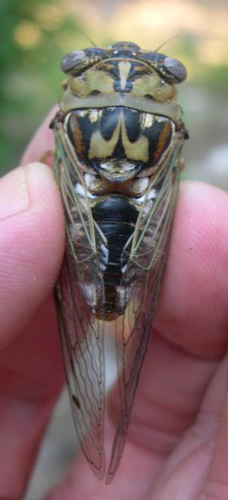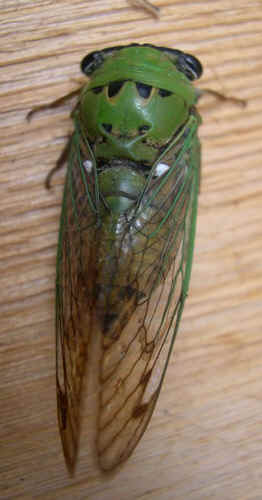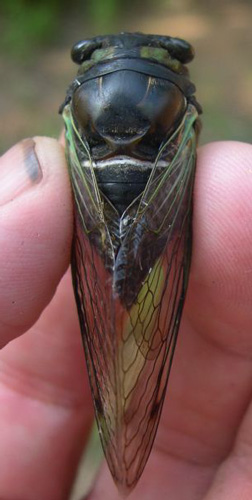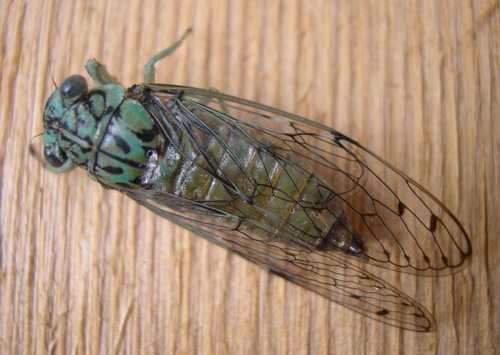
 
|
Return to Texas Entomology - Compiled by Mike Quinn

 
|
| Resh Cicada | Superb Green Cicada | Texas Dog-day Cicada | Annual Cicada |
|
Tibicen resh (Haldeman) |
Tibicen superba (Fitch) |
Tibicen texanus Metcalf | Tibicen sp. |

|
Hieroglyphic Cicada
Neocicada hieroglyphica (Say)
All Photographs (except T. texanus) Courtesy of Brush Freeman
Sound Production:
Unlike crickets and grasshoppers which make sounds by rubbing their wings and legs together, male cicadas produce sound by vibrating special membrane-like structures (tymbals) on their abdomen. The male’s enlarged abdomen is mostly filled with an air sac that functions as a resonance chamber thus greatly amplifying their songs. (Triplehorn & Johnson, 2004)
Taxonomy: There are 166 species of cicadas in the United States and Canada. (Arnett, 2000)
North American Taxonomy: Checklist of Cicadas North of Mexico
Texas Taxa: There are over 40 species of Cicadas in Texas - Cicada Checklist of Texas - Bibby (1936)
Central Texas Cicada Species:
Boris Kondratieff identified the following five species of Cicadidae at UT's Brackenridge Field Laboratory in west Austin.
- Diceroprocta azteca (Kirkaldy) - SONG - Continuous, non-melodious, almost metalic "De-De-De-De-De-De-De-De-De-De..."
Pacarina puella Davis - SONG - Faint, barely perceptible, "Ti-ti-ti-ti-ti-ti-ti-ti-ti-ti-ti-ti..."
Tibicen dorsatus (Say) - SONG - Loud, continuous, not high pitched, "Ch-ch-ch-ch-ch-ch..."
Tibicen resh Haldeman - SONG - Starts ""Gar-Gar-Gar-Gar-Gar-Gar-..." at mid level, quickly increases in speed and volume, before dropping way off.
Tibicen superbus (Fitch) - SONG - Thin, non-musical buzz, interupted by two seconds of loud "Ch-ch-ch-ch-ch-ch"Taber & Fleenor (2005) report four cicadas from Palmetto State Park, Gonzales County, south of Austin:
Quesada gigas (Olivier) - Giant Cicada - locomotive whistle - Loudest insect in the Wetern Hemisphere
Tibicen pronotalis Davis (= marginalis) - SONG - Continous "Owee-Owee-Owee-Owee-Owee-Owee-Owee..."
Tibicen pruinosus (Say) - SONG - Starts with a continous "Owee-Owee-Owee-Owee-Owee-Owee-Owee" but then drops off into a thin buzz.
Tibicen superbus (Fitch) - SONG - Thin, non-musical buzz, interupted by two seconds of loud "Ch-ch-ch-ch-ch-ch"Taber & Fleenor (2003) reported two cicadas from Bastrop State Park:
Neocicada hieroglyphica (Say) - SONG - A few seconds of loud, sharp, high pitched, "Zee-Zee-Zee-Zee-Zee-Zee" that changes to a buzz, slowly drops in pitch and speed, only to start up again.
Tibicen resh Haldeman - SONG - Starts ""Gar-Gar-Gar-Gar-Gar-Gar-..." at mid level, quickly increases in speed and volume, before dropping way off.In 1933, Bromley reported from the post oak belt of east central Texas:
"East central Texas is a veritable cicada paradise. I have never visited a region where so many species are as abundant as occur in, for instance, the Madison County region. They are numerous in many parts of the post oak woods, but are most plentiful in the alluvial forests and groves in the lower grounds along the Navasota and Trinity Rivers. Here in June and July, the air is vibrant with the songs of Tibicen superba, T. pruinosa, T. resh, T. marginalis, T. chloromera, T. lyricen and Diceroprocta vitripennis. The chorus becomes most intense late in the afternoon, when pruinosa may predominate. The songs of the species mentioned differ considerably and are quite easily recognizable. Tibicen resh is often found in great numbers in some large detached oak or other tree standing in the open, the trunk of which may bear scores of the cast skins of this species. Resh may be silent for long intervals, when suddenly the whole population may burst into song simultaneously, resulting in an ear-splitting din which subsides as suddenly as it arose."
Diceroprocta vitripennis (Say) - SONG
Tibicen tibicen (Linnaeus) (= chloromerus) - SONG
Tibicen lyricen (DeGeer) - SONG
Tibicen pronotalis Davis (= marginalis) - SONG
Tibicen pruinosus (Say) - SONG
Tibicen resh (Haldeman) - SONG
Tibicen superbus (Fitch) - SONG
In addition to the above short lists of CenTex cicadas, following species (shown above) is common in Austin:Tibicen texanus Metcalf 1963 - SONG - High pitched, loud, continuous thin whine
Photos:
BugGuide - Iowa State University
Google Groups: Cicadas of Texas
|
||||||||
Predators:
Cicada Killer Wasps, Genus Sphecius spp. Two species are present in Texas (only four spp. occur in N. and C. America):
Sphecius grandis (Say)
Sphecius speciosus (Drury) - Photo - in flight with cicada
Parasites:
Cicada Parasite Beetles (Rhipiceridae), Texas taxa:
Sandalus niger Knoch - BugGuide Sandalus Info
Sandalus porosus LeConte
Translation:
chi·cha·rra f. (Spanish)
1. - cicada
2. colloquial (persona) - chatterbox
3. SPAIN: - nuisance
Loudest Cicada
The world's loudest insects are cicadas. The loudest of all insects may the Imperial Cicada (Pomponia imperatoria) of southeast Asian. Anecdotal accounts of their song suggest they are deafening. (Petti, 1997)
"Locusts"?
Cicadas are commonly referred to as locusts which are technically grasshoppers. This common reference began when early North American settlers encountered mass emergences of periodic cicadas. Using the Bible as a guide to plagues of insects, the closest match they found was locusts and so the name stuck...
Stamps and Trinkets
Cicadas have been featured on stamps from around the world, even the U.S...
This 33¢ stamp series was issued by the United States Postal Service on October 1, 1999 as part of the Insects & Spiders Issue series. Illustrated by Steve Buchanan.
Lucky Cicada key ring - Forest Bug Series - "Cicada sornd (sic) will emit when press" - made in China, other examples
Beauty: Many cicadas of southeast Asia are particularly beautiful, see Michel Chantraine Cicada Gallery #1, #2, #3
Bibliography:
Arnett, R. H. 2000. (Second Edition) American Insects: Handbook of the Insects of America North of Mexico. CRC Press, Boca Raton, FL. 1024 pp. [relevant page]
Bibby, F.F., 1936. The Cicadas of Texas (Homoptera: Cicadidae), MSc Thesis, Agricultural and Mechanical College of Texas, College Station, TX.
Bromley, S.W. 1933. Cicadas in Texas. Psyche 40(4): 130.
Burke, H.R. 1977. Horace Haldeman, Early Insect Collector in Texas. Melsheimer Entomological Series No. 22: 1-6.
Davis W.T. 1944. The remarkable distribution of an American cicada: a new genus, and other cicada notes. Journal of the New York Entomological Society 52: 213-223.
Duffels, J.P., & P.A. van der Laan. 1985. Catalogue of the Cicadoidea (Homoptera, Auchenorrhyncha) 1956-1980. W. Junk, Dordrecht. xiv + 414pp.
Hogue, C. L. 1994. Latin American Insects and Entomology. University of California Press. 594 pp.
Triplehorn, C.A. & N.F. Johnson. 2004. (Seventh Edition) An Introduction to the Study of Insects. Thomson Brooks/Cole, Belmont, CA. 864 pp.
Metcalf, Z.P. 1963. General Catalogue of the Homoptera. Fascicle VIII. Cicadoidea. Parts 1-2. USDA-ARS, Washington.
Moore, T.E. 1993. Acoustic signals and speciation in cicadas (Insecta: Homoptera: Cicadidae). Pp: 269-284 in Evolutionary Patterns and Processes, Linnean Soc. Symposium No. 14, D. R. Lees and D. Edwards (eds.). London: Academic Press.
Petti, J.M. 1997. Loudest. Chapter 24 in University of Florida Book of Insect Records, 2001. [PDF version]
Sanborn, A.F., and P.K. Phillips. 2013. Biogeography of the Cicadas (Hemiptera: Cicadidae) of North America, North of Mexico. Diversity 5(2): 166–239.
Sueur, J. 2002. Cicada acoustic communication: potential sound partitioning in a multispecies community from Mexico (Hemiptera: Cicadomorpha: Cicadidae). Biological Journal of the Linnean Society 75(3): 379-394.
Taber, S.W. & S.B. Fleenor. 2003. Insects of the Texas Lost Pines. Texas A&M University, College Station. 283 pp.
Taber, S.W. & S.B. Fleenor. 2005. Invertebrates of Central Texas Wetlands. Texas Tech University Press, Lubbock. 309 pp.
Wolda, H. 1989. Seasonal cues in tropical organisms. Rainfall? Not necessarily! Oecologia 80(4): 437-442.
Wolda, H. 1993. Diel and seasonal patterns of mating calls in some neotropical cicadas. Acoustic interference. Proceedings of the Koninklijke Nederlanse Akademie Van Wetenschappen 96: 369–381.
Young, A.M. 1980. Habitat and Seasonal Relationships of Some Cicadas (Homoptera: Cicadidae) in Central Costa Rica. American Midland Naturalist, 103(1): 155-166.
Young, A.M. 1981. Temporal Selection for Communicatory Optimization: The Dawn-Dusk Chorus as an Adaptation in Tropical Cicadas. American Naturalist, 117(5): 826-829.
Young, A.M. 1983. On the evolution of cicada X host-tree associations in Central America. Acta Biotheoretica 33(3): 163-198.
13 June 2015 © Mike Quinn / entomike@gmail.com / Texas Entomology